Chapter 2
Using Siri to Organize Your Life
In This Chapter
![]() Using Siri to add calendar appointments and reminders
Using Siri to add calendar appointments and reminders
![]() Getting Siri to tell you about existing appointments
Getting Siri to tell you about existing appointments
![]() Creating, accessing, and editing notes
Creating, accessing, and editing notes
![]() Having Siri set alarms on your iPhone, iPad, and iPod touch
Having Siri set alarms on your iPhone, iPad, and iPod touch
![]() Accessing the time (and timers) through Siri
Accessing the time (and timers) through Siri
![]() Instructing Siri to open apps for you
Instructing Siri to open apps for you
In Chapter 1, you find out about some of the amazing things Siri can do for you — at a high level. Time now to take a deeper dive into some of the ways Siri can help you stay organized and informed, wherever life takes you.
Specifically, Siri can seriously speed up common — and often mundane — tasks, such as adding entries to a calendar, setting a reminder to do something, making notes, and setting alarms.
Menial tasks that often take multiple steps when typing can be performed in mere seconds — with great accuracy — when you get to use your voice.
And with the latest Siri update, you can now have Siri open apps for you, which can save you time from trying to find them among your many dozens or hundreds of apps.
Siri is your savior, in other words, and so without further ado, I cover how to take advantage of your voice-activated personal assistant to get more done in less time.
Keeping a Calendar
Whether you rely on your smartphone personally or professionally (or, in all likelihood, a little bit of both), your trusty handheld device can definitely help you stay organized while on the go.
After all, unlike a paper day timer (if you remember those!), your smartphone can alert you to important meetings, wirelessly synchronize this information with other devices, and also let you easily search for entries by keyword.
Siri goes one step further by making it drop-dead simple to add or access calendar entries — without having to stop to manually type in all the information.
Adding new calendar entries
Adding a new calendar appointment using Siri is a breeze. Follow these steps:
1. Press and hold the Home button.
The little chime you hear means that Siri is listening for your instructions.
2. Tell Siri about a calendar appointment you want to make.
For example, say, “Remember to call Auntie Terry-Lynn at 5 p.m. tomorrow” or “Set up a meeting about the sales report at 9 a.m. Thursday.” (Figure 2-1 shows what a Meet-Wife-at-Noon request to Siri looks like.)
3. Confirm or cancel the appointment.
Say “Cancel” or “Yes” — or tap Cancel or Confirm — to either cancel or confirm the appointment.
Siri might warn you that your proposed appointment overlaps with an existing one. (See Figure 2-2.) Or Siri might ask you to confirm the person you want the meeting with (this could happen if you say, “John,” for example, and there are nine people named John in your Contacts). If you say or tap Cancel, Siri will stamp a red CANCELED notification across the screen, and you might see some words like “All right, I’ll leave it off your calendar.”
 Siri isn’t too picky: You can ask Siri to set up an appointment in a number of different ways. You can say, “Add calendar entry,” “New appointment with person,” “Set up a meeting,” or “Meet with person,” to name a few examples.
Siri isn’t too picky: You can ask Siri to set up an appointment in a number of different ways. You can say, “Add calendar entry,” “New appointment with person,” “Set up a meeting,” or “Meet with person,” to name a few examples.

Figure 2-1: Siri will open up your Calendar and add your requested appointment.
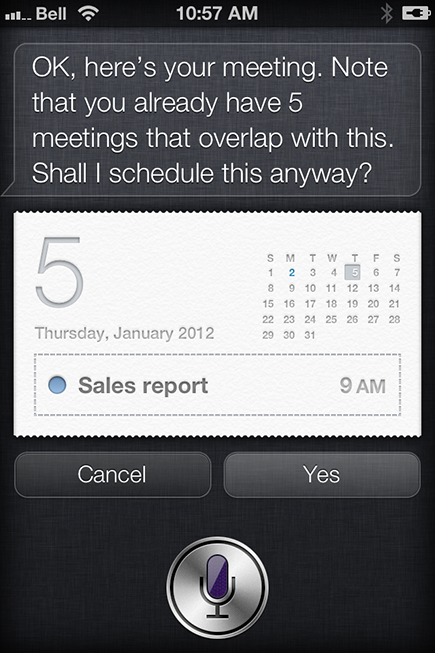
Figure 2-2: If there’s a calendar appointment overlap, Siri warns you about it.
Adding a new calendar entry — with location information
Along with the date and time, you can also use Siri to set a location for your appointment:
1. Press and hold the Home button.
2. Give Siri a calendar-related command.
Say something like, “Schedule a sales meeting tomorrow at 9 a.m. in the boardroom.”
3. Review what Siri is showing you.
Preview the calendar entry — time, subject, and place — before accepting the appointment. The location for the meeting displays underneath the subject, as shown in Figure 2-3.
 After Siri shows you the confirmed calendar appointment, you can tap the screen and it’ll open the Calendar app for you to add or edit details, if desired. Or maybe someone walked into the room and you’d rather type discreetly than talk out loud. Simply tap the Edit button, and you can make all kinds of alterations, including when the meeting starts and ends, the time zone, alerts and repeats, related websites, and notes. You can also delete the event from here, too. Just be aware that you can edit your spoken calendar entry with typed words, if you like.
After Siri shows you the confirmed calendar appointment, you can tap the screen and it’ll open the Calendar app for you to add or edit details, if desired. Or maybe someone walked into the room and you’d rather type discreetly than talk out loud. Simply tap the Edit button, and you can make all kinds of alterations, including when the meeting starts and ends, the time zone, alerts and repeats, related websites, and notes. You can also delete the event from here, too. Just be aware that you can edit your spoken calendar entry with typed words, if you like.
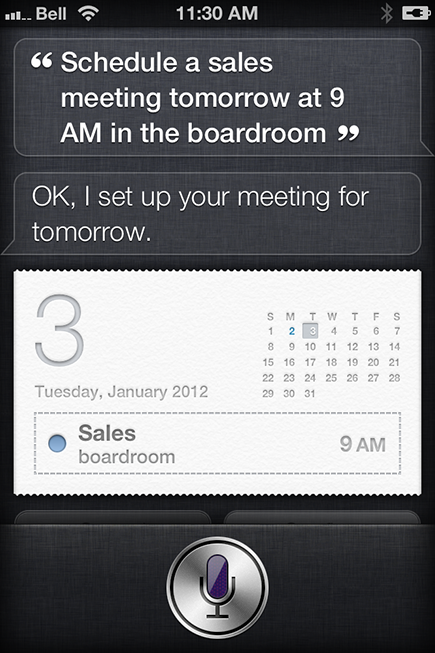
Figure 2-3: In this calendar entry, you see where the meeting is to be held (“boardroom”).
Making changes to calendar appointments
Siri can do more than just create a new appointment. You can also use Siri to review and change calendar appointments.
The following are a few examples of what you can say to Siri to change or cancel appointments when you’re on the run. Using Siri is much faster than doing these tasks yourself!
![]() Change an appointment. You can instruct Siri to do this for you. For example, tell Siri, “Move my 3:30 p.m. meeting to 4:30 p.m.” (See Figure 2-4.) You can also say, “Reschedule my appointment at 3:30 p.m. to next Tuesday at 1:30 p.m.”
Change an appointment. You can instruct Siri to do this for you. For example, tell Siri, “Move my 3:30 p.m. meeting to 4:30 p.m.” (See Figure 2-4.) You can also say, “Reschedule my appointment at 3:30 p.m. to next Tuesday at 1:30 p.m.”
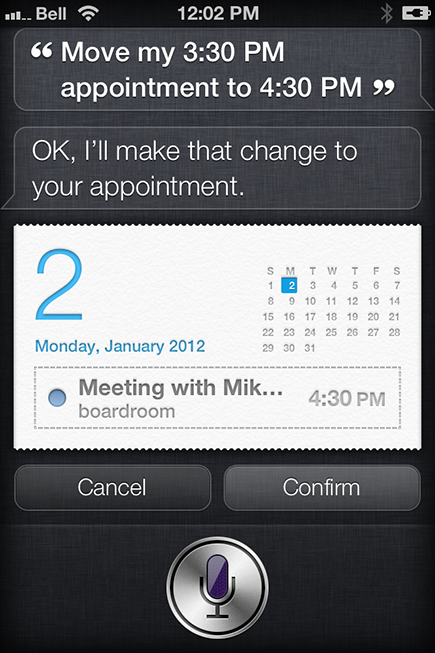
Figure 2-4: Changing an existing appointment to another time is as easy as pie.
![]() Cancel a calendar appointment. Tell Siri something like, “Cancel my 12 p.m. lunch meeting with Julie.” Or if you want to feel important — like those rich CEOs in the movies — you can even say something like, “Cancel my 1 o’clock!,” and Siri will ask you if you want to cancel the calendar appointment for that time. Have your people call my people.
Cancel a calendar appointment. Tell Siri something like, “Cancel my 12 p.m. lunch meeting with Julie.” Or if you want to feel important — like those rich CEOs in the movies — you can even say something like, “Cancel my 1 o’clock!,” and Siri will ask you if you want to cancel the calendar appointment for that time. Have your people call my people.
![]() Add someone to an existing calendar appointment. For example, tell Siri, “Add Mary Smith to my meeting at 3:30 p.m.” (Figure 2-5 shows you how Siri complies with your request.)
Add someone to an existing calendar appointment. For example, tell Siri, “Add Mary Smith to my meeting at 3:30 p.m.” (Figure 2-5 shows you how Siri complies with your request.)
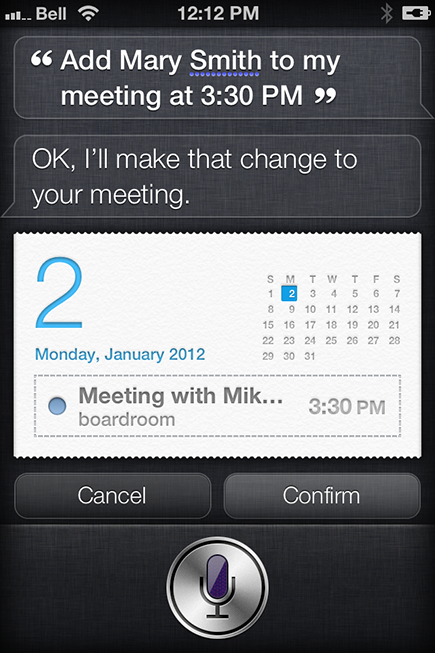
Figure 2-5: Based on your instructions, Siri adds Mary Smith to your appointment with Mike Jones.
Reviewing calendar appointments
Siri can also help you quickly review your calendar appointments. The following bullet list highlights a few examples of what you can ask Siri and what you see and hear in return:
![]() “What does my day look like?”
“What does my day look like?”
Siri shows you today’s calendar entries.
![]() “When is my next meeting?”
“When is my next meeting?”
Siri tells and shows you the time for your next appointment.
![]() “What do I have on Friday?” (See Figure 2-6.)
“What do I have on Friday?” (See Figure 2-6.)
Siri displays all calendar entries for a given date.
![]() “When am I meeting with Julie?”
“When am I meeting with Julie?”
Siri says and displays the time for your next appointment.
![]() “Where is my meeting with Steven?”
“Where is my meeting with Steven?”
Siri tells you the location for the relevant appointment and shows you the calendar entry, too.
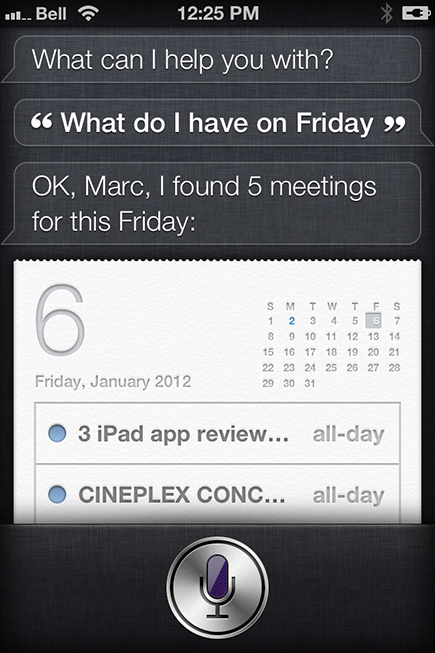
Figure 2-6: Ask Siri what’s on tap and you can see your calendar appointments.
Setting Reminders
Apple added a handy Reminders app to your iOS device, found on your Home screen (the front page of all your apps). As the name suggests, this app lets you create and view quite a few reminders — without having to add them to your calendar.
This pocket-sized to-do list, if you will, makes it easy to set or view reminders. For example, when viewing reminders, there are multiple ways to organize everything you have to do — be it by date, priority, location, or any custom-made list you want to create (such as Family Stuff, Work Notes, and so on). And of course, the Reminders app notifies you when you should do that thing you need to do.
Siri makes using Reminders a lot easier as it takes just a few seconds to instruct Siri to add a reminder to your to-do list.
The next sections explain how to get going.
Starting a reminder
If you’d like Siri to remind you to do something in the future, take out your Apple device and try the following operation:
1. Press and hold the Home button.
The familiar chime you hear lets you know that Siri is ready for action.
2. Tell Siri what you’d like to do.
Speak into your iPhone, iPad, or iPod touch with a command such as, “Remind me to buy milk, bread, and eggs today at 4 p.m.” or you can say something like, “Remember to thank John for the present.”
3. Glance at your screen to review your reminder. Or listen to Siri’s confirmation.
4. Assuming everything looks good to you, say or tap “Yes” to create the reminder. (If something isn’t quite right, say, “Cancel,” to cancel the reminder.)
Figure 2-7 shows you what a reminder confirmation from Siri looks like.
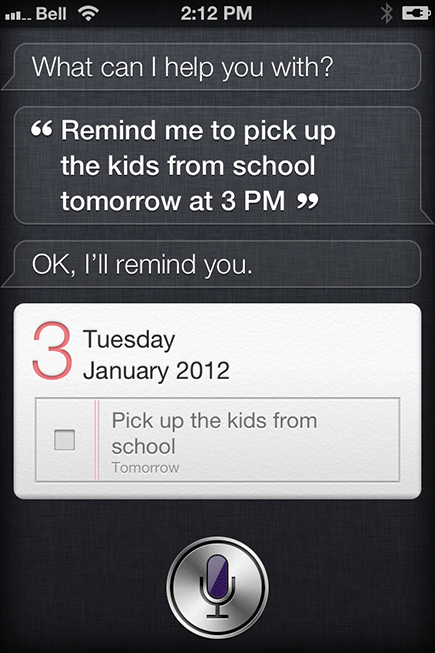
Figure 2-7: Here’s what a typical reminder confirmation looks like — after you’ve approved it.
Telling Siri when to remind you
If you tell Siri to remind you about something but don’t specify a time or date, you’ll be asked to do so on the spot. Neat, huh? This is how the exchange looks with Siri:
1. Press and hold the Home button.
You know that Siri is ready for instructions when you hear the familiar chime.
2. Tell Siri what to remind you of.
For example, say, “Remind me to call mom.”
3. When Siri prompts you to specify a date and/or time, tell Siri when you’d like to be reminded of whatever you stated needed reminding.
Figure 2-8 shows you what a reminder on your iPhone looks like.
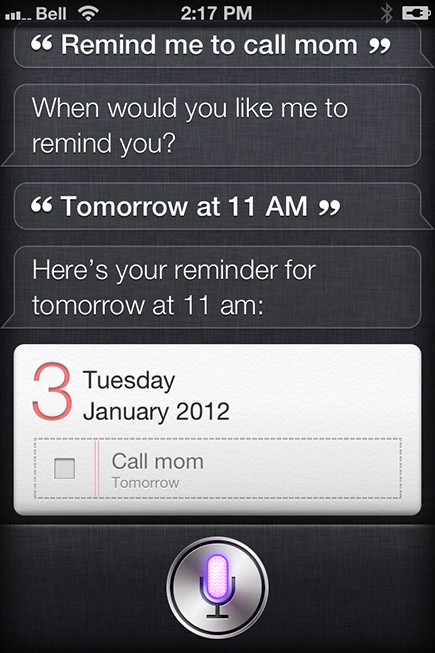
Figure 2-8: If you forget to tell Siri when to be reminded, you’ll be asked to set a date and time.
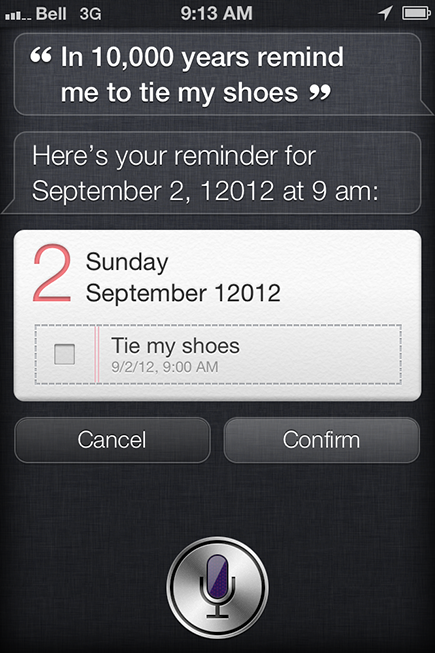
Figure 2-9: Wow — that’s thorough. Siri had better remind me to tie my shoes in the year 12,012.
Setting a location for your reminder
One of the coolest things about using Siri is you can ask to be reminded to do tasks by location, too. Because the iPhone and iPad are location-aware (thanks to its GPS, cellular, or Wi-Fi technologies), you can instruct Siri to remind you about something when you leave or arrive at a particular location. (However, for optimal performance, use cellular and GPS connectivity for location-based reminders.)
Here’s a quick step-by-step on using Siri to remind you about a task when you leave somewhere:
1. Press and hold the Home button.
The short beeping sound you hear indicates that Siri is ready.
2. Tell Siri to remind you about something — but at the end say, “when I leave here.”
For example, say, “Remind me to buy flowers and wine when I leave here.” (See Figure 2-10.) Another example: “Remind me to take an umbrella when I leave” (no “here” is necessary).
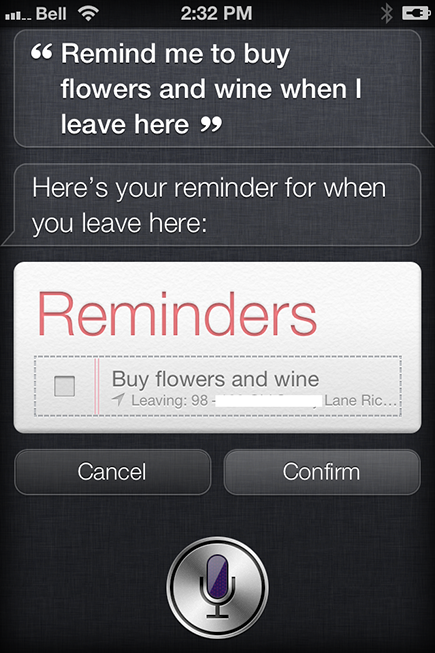
Figure 2-10: Siri displays your reminder request, with your geographical location info at the bottom of the reminder.
3. Preview the reminder and if it’s good, say “Yes” or “OK,” or tap “Confirm.”
You’ll see your address at the bottom of the reminder. (As you can see, I took the liberty of covering up my address for privacy reasons!) When you leave this address, your iPhone or iPad will remind you to pick up flowers and wine.
Now, say you want to be reminded about something when you arrive at a particular location? Here’s how to use Siri to perform this handy task:
1. Press and hold the Home button.
Siri tells you it’s time to speak your request with the familiar chime.
2. Tell Siri to remind you about something but add the words “when I get to destination.”
For example, you can say, “Remind me to FaceTime with Mary Smith when I get home” or “Remind me to talk to John about the contract renewal when I get to the office.”
3. Siri sets the reminder — and location — and asks that you confirm the details.
If Siri doesn’t know your home or business address, you’ll be asked to fill in this information in your Contacts (and Siri will open it up for you), as shown in Figure 2-11.
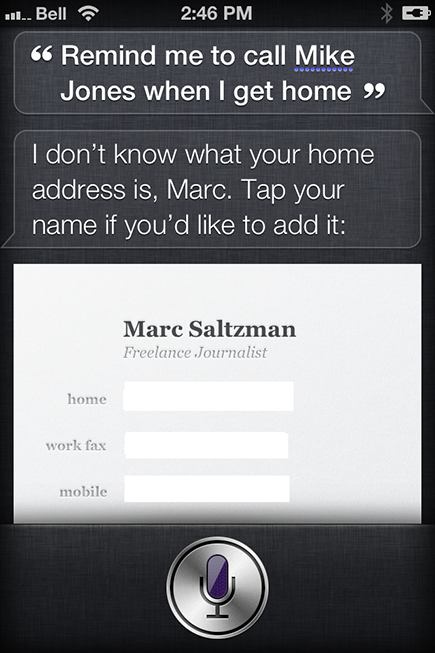
Figure 2-11: Siri didn’t know my home address, so I was prompted to give it (just once).
Previewing your reminders
You can also ask Siri to preview your reminders. She won’t read them to you verbally, but she will tell you if you have any you should know about and display them on the screen.
To preview your reminders, follow these steps:
1. Press and hold the Home button.
Hearing the Siri chime is your cue to begin speaking.
2. Ask Siri if you have any reminders.
You can ask it in different ways, but it might be easiest to ask, “Do I have any reminders today?” Or you can ask “Do I have any reminders tomorrow?” or “Do I have any reminders next week?”
Siri displays whatever reminders you have listed in the Reminders app for a given date or location.
As shown in Figure 2-12, you can ask Siri to show you reminders by location, too (in this case “at home”).
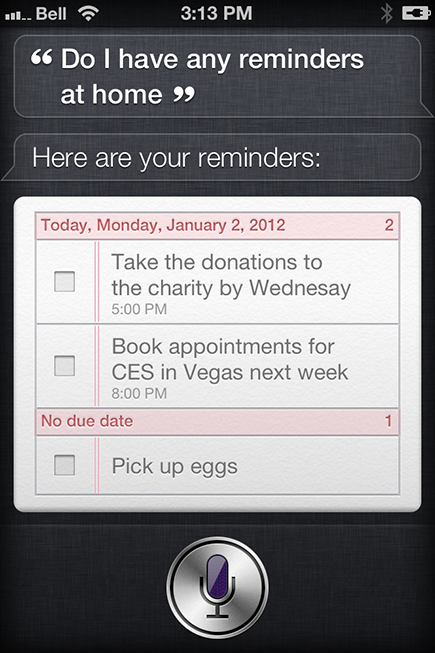
Figure 2-12: You can ask Siri to show you a list of uncompleted reminders.
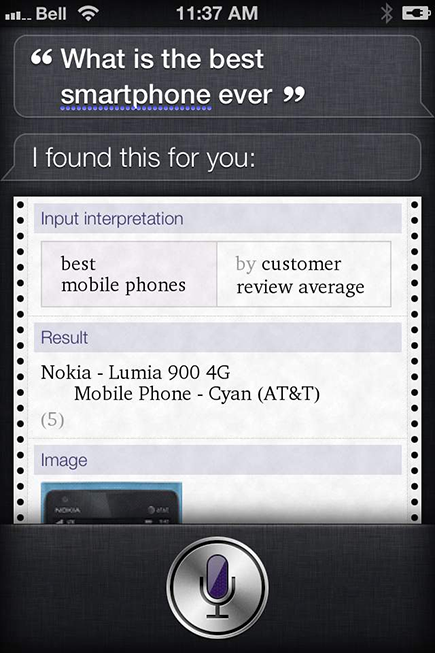
Figure 2-13: This is what you saw in the spring of 2012, when you asked your iPhone to tell you the name of the best smartphone.
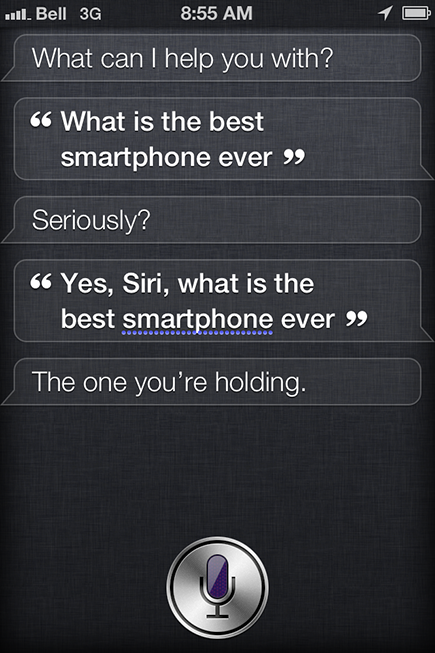
Figure 2-14: Hmm, did Siri change its mind overnight? You see this reply if you ask the same question. As you can see, I asked twice.
Taking Notes
As with most smartphones and tablets, the iPhone, iPad, and iPod touch ship with a Notes app — all decked out to look like yellow, lined pieces of paper — allowing you to jot your thoughts down whenever they pop into your head.
The Notes app isn’t a full-blown word processor — for example, there are only three font styles to choose from — but it’s an ideal tool to flesh out ideas and make lists and such. And with iCloud, Apple’s handy way of synchronizing all of your digital info and media over the Internet (between supported devices), all your notes can be synched with all your devices, too.
You can, of course, manually tap to open the Notes application, start a new note, and begin typing — or you can be smart and have Siri do it for you.
You can use Siri to start a new note, add words to an existing note, and pull up notes based on keywords.
Creating a new note
Here’s a look at the first task I mentioned, starting a new note:
1. Press and hold the Home button.
You hear the familiar tone, which is your cue to begin talking.
2. Instruct Siri to create a new note for you.
You can say something like, “Note that I spent $50 on the fantasy football pool,” “Create a note called ‘Buy these books for mom,” or “Take a note to pick up that new Xbox 360 game for Steve.”
Siri opens up the Notes app, begins a new note with the name you’ve given it, and then shows you the note it just created for you. (See Figure 2-15 for an example of Siri’s response when I ask her to create a note.) The first few words of your spoken note become the name for the note, but you can change that if you like.
 You won’t get a chance to accept or cancel the note Siri creates for you. If you don’t want to keep the note, you’ll need to manually open up the Notes app and remove it. You can’t delete notes using Siri.
You won’t get a chance to accept or cancel the note Siri creates for you. If you don’t want to keep the note, you’ll need to manually open up the Notes app and remove it. You can’t delete notes using Siri.
Adding more to an existing note
If you’ve created a note on your iOS device and you want to add more to it, you can do so very easily with Siri’s help. All you need to know is what the note is called (or as you’ll see shortly, you can do a search by keyword), and you can add more text using your voice.
Here’s how to get going:
1. Press and hold the Home button.
You know it’s time to talk after you hear the familiar chime.
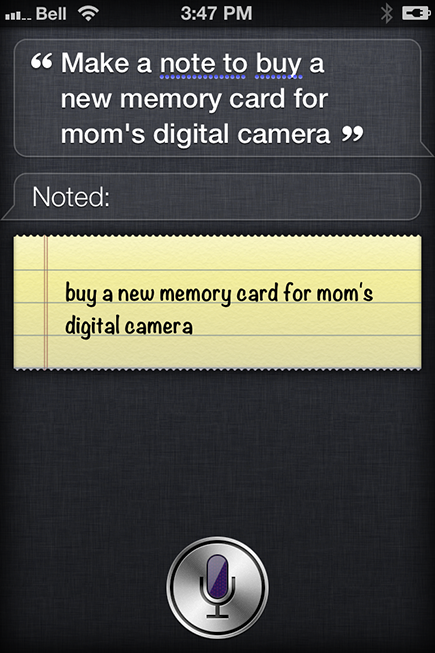
Figure 2-15: Siri can help create notes for you on the fly.
2. Tell Siri something like, “Add cereal to Shopping List note.”
Remember, the note you’re adding the extra words to must already be in your Notes app. Remember, when you start a new note, the first few words will be the title for the note.
3. Look at the screen to see the note — and what has just been added — and, assuming it’s all good, you can put the phone away.
See Figure 2-16 for an example.
4. (Optional) If you need to edit the entry, tap the message, and the Notes app opens.
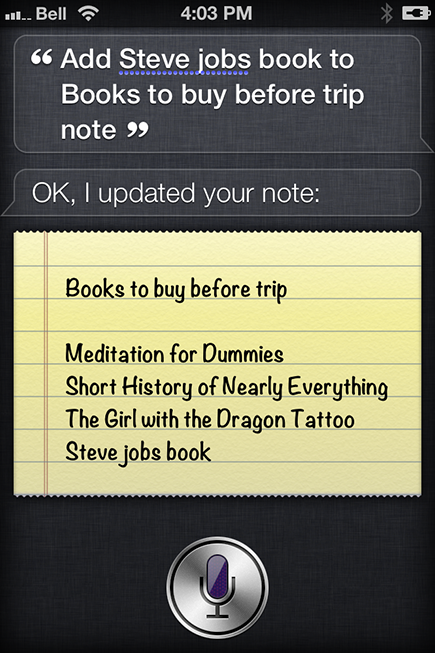
Figure 2-16: Add more information to an existing note using Siri.
Finding notes
Your voice-activated personal assistant can also be used to find existing notes on your iPhone, iPad, or iPod touch.
Perhaps you’re looking for that grocery list while standing in your local supermarket? Or maybe you want to add more detail to your million dollar idea?
Instead of manually scrolling through all your notes, you can ask Siri to show you all relevant notes by saying a keyword — or all your notes, if you prefer.
Here’s a quick guide on what to ask Siri:
1. Press and hold the Home button.
You can begin talking after you hear the short chime.
2. Either ask Siri to display all your notes or ask her to look for one in particular.
Tell Siri, “Show me all my notes,” and you’ll see a list of them, from newest to oldest, as shown in Figure 2-17. Tap a note to open one up. Alternatively, ask Siri to look for a particular note by telling her something along the lines of, “Show me ‘book’ notes,” which will have her call up all notes containing the word “book.” (See Figure 2-18.)

Figure 2-17: Siri can show you all your notes, if you ask it to do so.

Figure 2-18: I asked Siri to show me all notes with the word book in them.
Setting Alarms, Clocks, and Timers
You can quickly set an alarm on any Siri-enabled iOS device by asking “her” to set it for you.
Before I show you how to do this (very) simple task, I want you to think of all the steps involved if you didn’t use Siri. Say you want to be woken up tomorrow at 7 a.m. Without Siri, you’d have to open up your Clock app, tap on Alarm at the top of the screen, and then tap + to set a new alarm. Now you must select a time (for example, 7 a.m.) and tap Save. Geez, that’s a drag, no?
With Siri, all you have to do is ask her to set an alarm at a given time. Two to three seconds at most, and you’re done.
Setting an alarm
Here’s the easiest way to set an alarm:
1. Press and hold the Home button.
You can ask to set an alarm right after you hear the chime.
2. Say what time you want the alarm to go off.
For example, say, “Wake me up at 7 a.m. tomorrow.” (See Figure 2-19.) Siri will show you the alarm, based on your request.
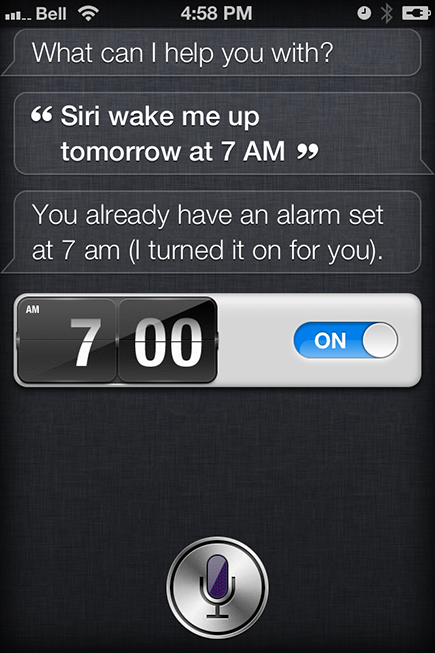
Figure 2-19: In this case, the alarm was previously set and turned off, so Siri turned the alarm back on for me.
You can close this app if it’s correct or swipe to turn it off if it’s not.
Siri has additional alarm features that enable you to instruct Siri to do the following:
![]() Want to take a nap?
Want to take a nap?
Tell Siri, “Wake me up in one hour.”
![]() Need to sleep in a little longer tomorrow?
Need to sleep in a little longer tomorrow?
Instruct Siri to “Change my 7 a.m. alarm to 7:30 a.m.”
![]() Want to call in sick?
Want to call in sick?
Say, “Cancel my 7 a.m. alarm.”
![]() Want to remove the alarm notification altogether?
Want to remove the alarm notification altogether?
Tell Siri, “Delete my 7 a.m. alarm.”
Finding out what time it is
Siri can give you the time — locally or in another city altogether. Siri can also tell you today’s date.
Want to call a colleague’s mobile phone in Hong Kong but don’t want to call too late or too early? Here’s what to do:
1. Press and hold the Home button.
You hear a chime, which means Siri is ready for you to ask her a question.
2. Ask Siri what time is it in Hong Kong.
Within a second or two, you can see the exact time in Hong Kong. (See Figure 2-20 for an example.)

Figure 2-20: Siri shows you the current time in Hong Kong — and tells you that it’s tomorrow’s date, too.
Setting and adjusting timers
Finally, speaking of clocks and alarms, Siri can also be used to set a timer on your iPhone, iPad, or iPod touch.
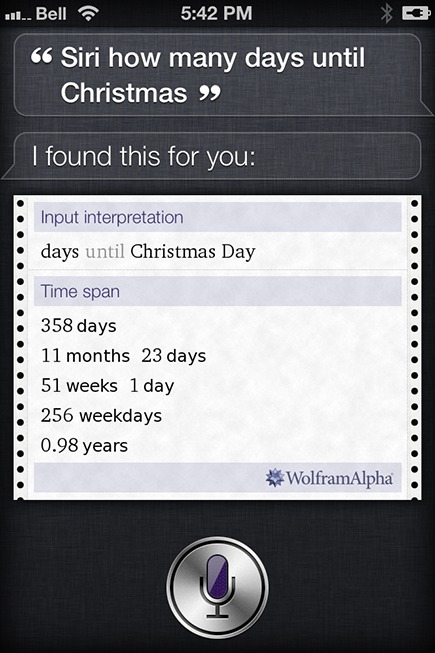
Figure 2-21: I asked Siri to tell me how many more days until Christmas, and she broke it down for me.
Whether you want to know when to check the oven, leave the house to pick up the kids from a play date, or stop jogging around the neighborhood, you can easily set a timer using voice commands. It’s as easy as this:
1. Press and hold the Home button.
Listen for the chime and begin speaking.
2. Instruct Siri to set a timer.
You can say the duration of the timer right away (see Figure 2-22) or say, “Set a timer,” and Siri will ask you, “For how long?” However you set the duration, when that’s done you’ll see the timer start.
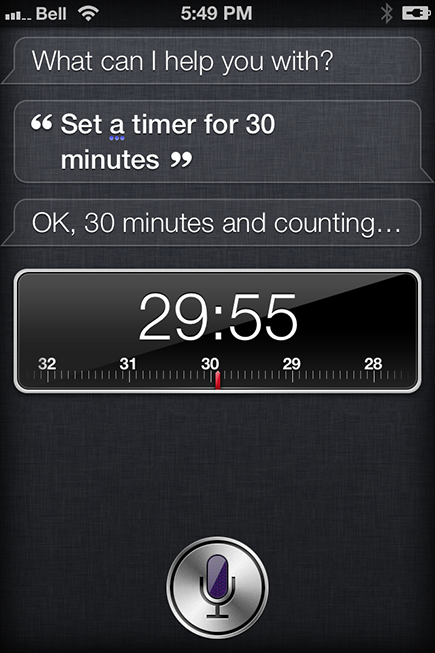
Figure 2-22: Don’t let that roast burn in the oven! Siri can set a timer for you in a flash. All you have to do is ask.
3. Preview the timer information at a glance.
 Tap the timer info if you want to
Tap the timer info if you want to
• Change when the timer ends.
• Change the kind of alarm that sounds (by default it’s Marimba).
• Pause the timer.
For even more fun, try these other timer-related commands with Siri:
![]() “Show the timer.”
“Show the timer.”
![]() “Pause the timer.”
“Pause the timer.”
![]() “Resume the timer.”
“Resume the timer.”
![]() “Cancel the timer.”
“Cancel the timer.”
Opening Apps with Siri
One of the new Siri features introduced with the Apple iOS 6 platform is the ability to open up any app on your iPhone, iPad, or iPod touch by using your voice.
There are a couple of ways to open up your apps, based on your wording and what apps they are, but Siri will handle most apps with this simple request “Open [app].” That’s it!
Here’s an example:
1. Press and hold the Home button.
You’ll hear the familiar Siri chime, which means that Siri is ready for you.
2. Tell Siri to open an app, such as “Open photos” or “Open iTunes U.”
Within a second or so, the app you asked for will be open and ready for action.
 This task is performed faster if the app was recently opened (it’s simply minimized in the background).
This task is performed faster if the app was recently opened (it’s simply minimized in the background).
There’s not much to illustrate here because Siri doesn’t show you anything — other than your verbal request. See Figures 2-23 and 2-24 for an example of what this looks like. Siri does not give you a verbal confirmation for this task, by the way.

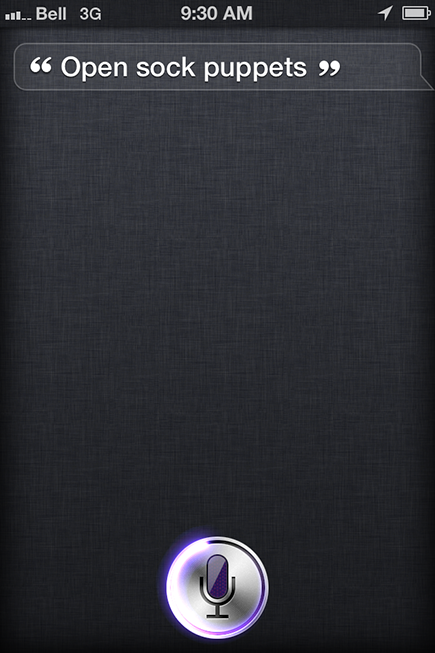
Figure 2-23: Siri confirms your request by showing what you asked on the screen, just before the task is performed.

Figure 2-24: A mere second or two later, you see the app open on your iPhone, iPad, or iPod touch. In this case, it’s the entertainment app Sock Puppets. (Try it — you’ll like it.)

 Because it takes only a quick Siri request to set up a reminder, you might be tempted to do this while driving. But even a minor distraction could cause an accident, so resist using Siri until you’ve parked the car.
Because it takes only a quick Siri request to set up a reminder, you might be tempted to do this while driving. But even a minor distraction could cause an accident, so resist using Siri until you’ve parked the car.